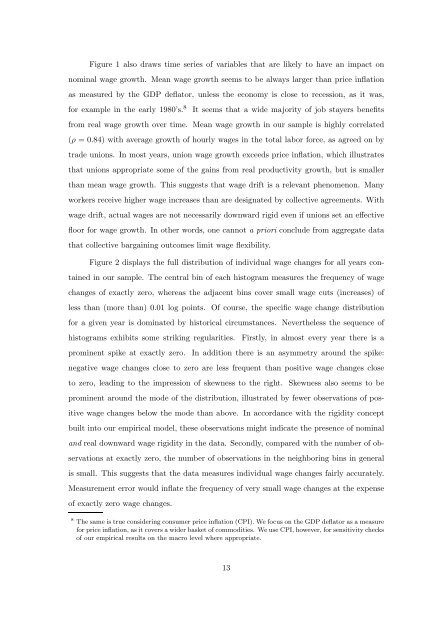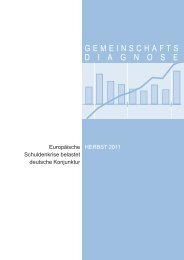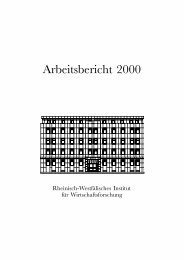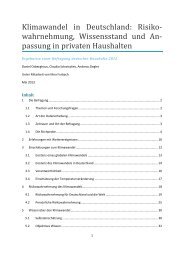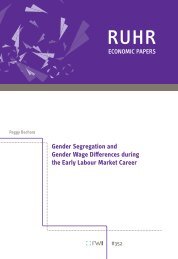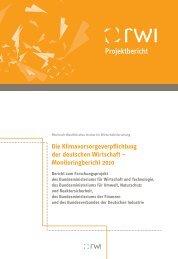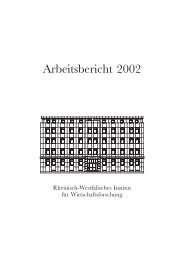RW I:Discussion Papers - Rheinisch-Westfälisches Institut für ...
RW I:Discussion Papers - Rheinisch-Westfälisches Institut für ...
RW I:Discussion Papers - Rheinisch-Westfälisches Institut für ...
You also want an ePaper? Increase the reach of your titles
YUMPU automatically turns print PDFs into web optimized ePapers that Google loves.
Figure 1 also draws time series of variables that are likely to have an impact on<br />
nominal wage growth. Mean wage growth seems to be always larger than price inflation<br />
as measured by the GDP deflator, unless the economy is close to recession, as it was,<br />
for example in the early 1980’s. 8 It seems that a wide majority of job stayers benefits<br />
from real wage growth over time. Mean wage growth in our sample is highly correlated<br />
(ρ =0.84) with average growth of hourly wages in the total labor force, as agreed on by<br />
trade unions. In most years, union wage growth exceeds price inflation, which illustrates<br />
that unions appropriate some of the gains from real productivity growth, but is smaller<br />
than mean wage growth. This suggests that wage drift is a relevant phenomenon. Many<br />
workers receive higher wage increases than are designated by collective agreements. With<br />
wage drift, actual wages are not necessarily downward rigid even if unions set an effective<br />
floor for wage growth. In other words, one cannot a priori conclude from aggregate data<br />
that collective bargaining outcomes limit wage flexibility.<br />
Figure 2 displays the full distribution of individual wage changes for all years contained<br />
in our sample. The central bin of each histogram measures the frequency of wage<br />
changes of exactly zero, whereas the adjacent bins cover small wage cuts (increases) of<br />
less than (more than) 0.01 log points. Of course, the specific wage change distribution<br />
for a given year is dominated by historical circumstances. Nevertheless the sequence of<br />
histograms exhibits some striking regularities. Firstly, in almost every year there is a<br />
prominent spike at exactly zero. In addition there is an asymmetry around the spike:<br />
negative wage changes close to zero are less frequent than positive wage changes close<br />
to zero, leading to the impression of skewness to the right. Skewness also seems to be<br />
prominent around the mode of the distribution, illustrated by fewer observations of positive<br />
wage changes below the mode than above. In accordance with the rigidity concept<br />
built into our empirical model, these observations might indicate the presence of nominal<br />
and real downward wage rigidity in the data. Secondly, compared with the number of observations<br />
at exactly zero, the number of observations in the neighboring bins in general<br />
is small. This suggests that the data measures individual wage changes fairly accurately.<br />
Measurement error would inflate the frequency of very small wage changes at the expense<br />
of exactly zero wage changes.<br />
8 The same is true considering consumer price inflation (CPI). We focus on the GDP deflator as a measure<br />
for price inflation, as it covers a wider basket of commodities. We use CPI, however, for sensitivity checks<br />
of our empirical results on the macro level where appropriate.<br />
13


